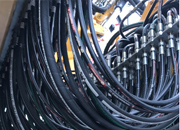How to Choose an Oil Drilling Hose
2022-08-15 10:11:30
When choosing an Oil drilling hose, there are several factors to consider. Choosing the wrong one can cause the drilling operation to halt. This can be prevented by keeping track of the hose's life span and replacing it often. Look for unusual pulsations in the hose. These could be due to a compensator unit malfunctioning, causing premature hose failure. These steps will help you track the condition and quality of your hose.
Oil drilling hose
An oil drilling hose, a flexible pipe that allows the transmission of drilling fluid, is called an oil drilling hose. The flexible design allows it move vertically while the steel cable reinforcement reduces eddy current generation. This hose can also be used to transport oil, water, and other high-pressure media. Here are some important characteristics to know before purchasing one. Listed below are some of the most important benefits of oil drilling hose. They will also help you to save time and money when it comes to drilling operations.
The hose is made of three main parts: the tube, which is made of synthetic rubber, and a reinforcement layer of spiraled steel wire, which gives it excellent strength and resistance to high-pressure working conditions. The cover is made from high-quality synthetic rubber. It is made from chloroprene rubber. It is resistant to sunlight, aging, and abrasion. Oil drilling hoses are classified according to their working pressure into five grades.
API 7K
An API 7K oil drilling hose is designed specifically for deep oil drilling applications. This hose meets the API standards for safety, quality, and durability. API is the acronym for the American Petroleum Institute, and it sets three levels of safety and quality requirements for hoses. FSL 0, the lowest level, is FSL 0. FSL 1 and FSL 2 represent the highest quality and safety. Regardless of which level of hose you need, you can rely on a ContiTech oil drilling hose to meet these strict requirements.
A high-tensile steel cable reinforced polyester cord hose is suitable for rotary drilling. NBR cover is chemical, abrasion, and oil resistant. NBR hoses come in various lengths from 5 feet to 90 feet. Hoses are supplied with male API threaded ends and can be fitted with swivels, flanges, and unions. You can request a custom length hose if you require a longer hose.
API 16C
For under-balance operations (UBO), which is a type of drilling where returns are achieved by lowering the equivalent oil drilling hose to API 16C below open-hole pressure, a good API 16C oil drilling tool is essential. These operations differ from gas and air drilling, which are performed at elevated pressures. A good hose meets API 16C's requirements by providing equal diameter and high pressure. It is used in many land-oil drilling projects.
The API 16C oil drilling hose has a minimum bending radius. This is the smallest bend within API Spec 7K. It is determined by calculating the Minimum Bending Radius (MBR) of the hose by Equation A.1. In addition, a hose should be protected from damage from kinking or rupture. An API 16C oil drilling hose is also flexible enough to accommodate a variety of bending patterns.